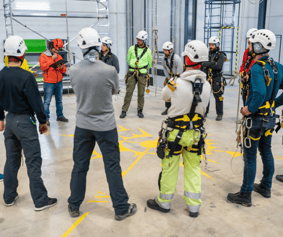A safe work environment for you and your employees is crucial in running a business. Let’s start with the basics. Knowing the hazards in a workplace and the safety equipment available to you and your employees is a great place to start. After looking at the basics of workplace safety we’ll explore seven tips for keeping your business safe.
Hazards in the Workplace
Injuries in the workplace happen all the time. Many accidents happen on construction sites, such as falls and heavy equipment malfunction. It doesn’t matter where you work though. You could simply trip over a trash can in the office resulting in an injury as well. While insurance is helpful when dealing with life’s accidents, being safe should always be your top priority.
Here are six types of hazards in the workplace everyone should be aware of:
- Safety
- Biological
- Physical
- Ergonomic
- Chemical
- Work organization
To learn more about each of these hazards, visit SafetyLine.
Workplace Safety Equipment
Because of the many hazards in the workplace, there’s a variety of safety equipment available. This equipment can include industrial barrier products, such as noise control systems, vinyl strip doors, fire safety equipment, and welding and safety screens. These are all products that can be used to keep a workplace safe.
Besides barrier products there are other items, such as personal protective equipment (PPE). Some PPE examples include helmets, safety glasses or goggles, earplugs or earmuffs, masks, boots, and gloves.
Tips for a Safe Workplace
Here are seven tips for providing a safe workplace.
1. Ensure employees use tools, equipment, and machinery properly.
Injuries in the workplace are bound to happen. However, injuries can be lessened or avoided if employees are trained on how to properly use the equipment, and measures are put in place to monitor and ensure compliance. Additionally, be sure your machinery receives regular cleaning and maintenance.
2. Provide employees with a process for reporting unsafe conditions.
Unsafe conditions need to be addressed immediately. Instruct employees to notify a supervisor as soon as they see anything that could result in injury.
3. Enforce employees wearing the proper safety gear.
As previously discussed, there are many hazards in the workplace, so having employees wear the necessary safety equipment for your environment is critical. For example, in a hospital, employees should wear protective medical gloves and masks. However, on a construction site, employees should wear helmets, protective gloves, and items to protect them from the outdoor elements.
4. Require employees keep workspaces free from clutter.
Clean workspaces not only make it easier from employees to get their work done, they also can help prevent injuries by eliminating trip and fall hazards.
5. Instruct employees on proper posture when sitting or lifting.
Regardless of the work environment and work being performed, poor posture can cause strain on employees’ backs, shoulders, necks, legs, and arms. Train your employees on the proper ergonomics for their job responsibilities and provide them with the necessary equipment to maximize comfort and efficiency.
6. Remind employees to always be aware of their surroundings.
Here are some examples of possible risks or other elements employees should be aware of
- Spills or items on the floor
- Hazardous materials
- Locations of first aid kits and emergency exits
- Emergency procedures
7. Train employees on new safety procedures.
Notify employees immediately of any new or modified safety procedures. Ensure employees understand and give them an opportunity to ask questions. Keep in mind, depending on the type and scope of the procedure, communication method may vary from written notification to in-person training.
There are many things to consider when it comes to safety in the workplace. Knowing and understanding the risks and mitigation techniques will help keep your work environment safe for everyone.
This post was written by a guest blogger, Michelle Bierbower.




